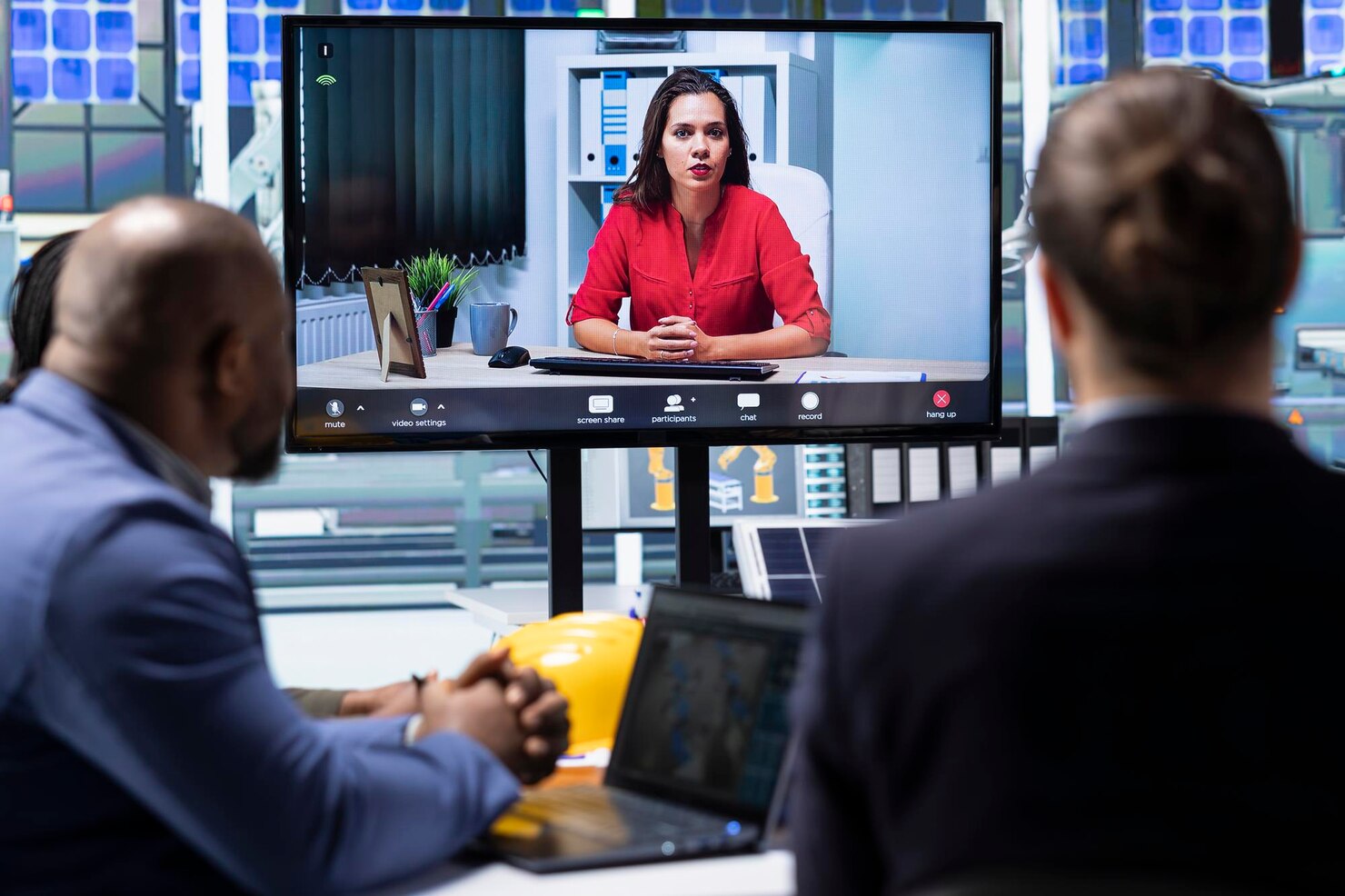In the modern business world, the ability to communicate and collaborate in real time is more important than ever. As companies embrace remote work, hybrid models, and global teams, effective communication is crucial to maintaining productivity, fostering collaboration, and ensuring that everyone remains connected. One of the most effective tools for achieving this is a video conferencing system.
With the right solution, teams can easily conduct meetings, share documents, and collaborate on projects, all from different locations. This guide will explore the importance of these systems, their key components, benefits, best practices, and how they can transform the way your team works. Let’s dive into how these systems can improve business communication, boost efficiency, and create a more collaborative environment.
What is a Video Conferencing System?
A system allows individuals or groups to connect, communicate, and collaborate using video and audio via the internet. It is typically equipped with cameras, microphones, speakers, and software that facilitate face-to-face meetings, even when participants are miles apart. The system enables real-time interaction, bringing people together for discussions, brainstorming sessions, presentations, and more.
A good system is more than just a way to see and hear others. It includes a combination of hardware and software that works seamlessly to provide clear communication, ensure smooth collaboration, and reduce the frustrations of traditional meeting setups. As remote work and global teams continue to rise, the demand for reliable, high-quality communication solutions has increased exponentially.
Key Components
A video conferencing system consists of several components that work together to ensure smooth communication. These include:
- Cameras: High-definition (HD) cameras are a critical component of the system. They ensure that all participants are visible and allow for a more personal meeting experience. Some systems may include cameras with pan-and-tilt functionality, which can automatically adjust the frame to capture the speaker.
- Microphones: Clear audio is vital for effective communication in virtual meetings. Microphones pick up the sound of the speaker, allowing all participants to hear the conversation. For larger rooms, microphones may be placed strategically around the space to capture sound from all directions.
- Speakers: Quality speakers ensure that everyone can hear the audio. Many systems integrate high-quality speakers that reduce distortion and improve sound clarity, enhancing the overall meeting experience.
- Displays: Large displays are essential for video conferencing, as they allow participants to view each other. Displays can also be used to share content, such as presentations, documents, or multimedia, so that all attendees can easily follow the conversation.
- Software: Video conferencing software (such as Zoom, Microsoft Teams, or Google Meet) is the backbone of any conferencing system. It connects participants, allows for screen sharing, facilitates chat, and manages meeting settings. Software often integrates with other tools, such as calendar systems, to make scheduling and meeting management easy.
- Network Connection: A stable and high-speed internet connection is necessary for ensuring smooth video and audio quality. Slow or unstable internet can lead to disruptions in the meeting, such as video freezing, audio cutouts, or lag.
- Control System: Some advanced systems feature touch-panel controls, which allow users to manage various aspects of the meeting, such as adjusting the volume, managing the camera, and sharing screens.
Benefits of a Video Conferencing System
Improves Communication
This system enhances communication by allowing participants to see and hear each other in real time. This visual element adds nuance and depth to the conversation, allowing for better understanding and collaboration. Non-verbal cues such as facial expressions and body language can be seen, which often help reduce misunderstandings that can occur in text-based communication or audio calls.
Boosts Productivity
Time is one of the most valuable resources in business. With this system, employees no longer need to waste time traveling to meetings. Instead, they can join virtual meetings from anywhere, whether from home, the office, or while on the go. This flexibility allows teams to hold more frequent meetings and collaborate more efficiently, resulting in a significant boost in productivity.
Cost-Effective Solution
Travel expenses for in-person meetings, particularly for global teams, can add up quickly. This system eliminates the need for travel, saving businesses significant amounts of money. Instead of flying employees across the country or internationally for a one-hour meeting, companies can use this solution to conduct the same meeting virtually, at a fraction of the cost.
Supports Remote Work
The shift to remote work has made these systems even more important. A well-implemented system ensures that remote workers can easily participate in team meetings, collaborate on projects, and engage with colleagues and clients. This level of inclusivity makes remote work more feasible and efficient.
Promotes Flexibility and Collaboration
This solution enables teams to be more flexible. Whether it’s a quick check-in with a team member or a full-on brainstorming session with remote colleagues, the ability to connect virtually allows for seamless collaboration. Multiple team members can share their screens, exchange ideas, and work together without being restricted by location.
Enhances Customer Interactions
In addition to improving internal communication, these systems can also enhance interactions with clients. Businesses can host client meetings, product demonstrations, or support sessions. This not only strengthens client relationships but also provides a more personal touch compared to phone or email communication.
Best Practices for Implementing
A video conferencing system is only as effective as how well it’s implemented and used. To ensure smooth, productive meetings, consider the following best practices:
1. Choose the Right Software
The software you choose for your video conferencing system is crucial to the success of your virtual meetings. Consider the features that your team needs, such as screen sharing, recording capabilities, chat functionality, and integration with other tools. Popular options include Zoom, Microsoft Teams, Google Meet, and Skype.
2. Invest in High-Quality Equipment
While software is essential, the hardware that supports your video conferencing system plays a significant role. Invest in high-quality cameras, microphones, and speakers to ensure clear video and audio. If your meetings are held in larger spaces, consider using professional-grade equipment to capture sound and video from all angles.
3. Provide Proper Training
Proper training is key to ensuring that your team can effectively use the video conferencing system. Schedule a training session to familiarize employees with the software, the equipment, and the best practices for video conferencing. This can include how to adjust settings, mute/unmute audio, share content, and troubleshoot common issues.
4. Optimize Your Meeting Space
Your physical environment plays an important role in the quality of your video calls. Ensure that the meeting room is well-lit, with the light directed at the faces of the participants, not behind them. Avoid background noise and distractions. Make sure the camera is positioned properly to capture the speaker and the audience.
5. Ensure a Stable Internet Connection
A fast and stable internet connection is crucial for seamless video conferencing. If your internet connection is weak, video and audio quality may suffer. Ensure that your network can handle video streaming without interruptions or lag. If necessary, consider upgrading your internet speed to meet the demands of your team.
6. Maintain Security and Privacy
Security is a growing concern for remote meetings, especially when discussing sensitive or confidential information. Use strong passwords, enable meeting waiting rooms, and ensure that your video conferencing software is up to date with the latest security patches. If possible, enable encryption for meetings to protect private data.
Common Challenges
While video conferencing systems offer tremendous benefits, they can present certain challenges. Here are some of the common issues you may encounter:
1. Technical Issues
Technical difficulties such as poor internet connectivity, software glitches, or hardware malfunctions can disrupt meetings. To minimize these issues, always test the system before meetings and ensure you have technical support available in case of emergencies.
2. Lack of Engagement
Virtual meetings can sometimes feel less engaging than in-person meetings. Encourage active participation by asking questions, using interactive features such as polls or reactions, and maintaining a dynamic meeting agenda.
3. Time Zone Differences
When working with remote teams across different time zones, scheduling meetings can be tricky. Use scheduling tools that allow you to find mutually available times for all team members, ensuring that no one has to join at inconvenient hours.
Frequently Asked Questions
1. What equipment do I need for a video conferencing system?
To set up a basic video conferencing system, you will need a camera, a microphone, speakers, a computer or smart device, and reliable video conferencing software. For larger meeting rooms, you may need additional equipment such as ceiling microphones and multiple monitors.
2. How do I choose the right video conferencing software?
Consider factors such as ease of use, compatibility with other tools (like calendars and file-sharing platforms), security features, and the number of participants it can accommodate. Zoom, Microsoft Teams, and Google Meet are all popular choices.
3. Can I use my personal laptop for video conferencing?
Yes, you can use a personal laptop or device for video conferencing, as long as it meets the system requirements for the software you are using. Ensure you have a working camera, microphone, and stable internet connection.
4. How secure are video conferencing systems?
Most video conferencing platforms offer robust security features, including encryption, password protection, and meeting waiting rooms to prevent unauthorized access. It’s important to use these features to ensure secure meetings.
5. How do I fix video or audio problems during a meeting?
If you’re experiencing issues with video or audio, first check your internet connection and make sure all hardware is connected properly. You can also try restarting the meeting software or using a different device if needed.
Conclusion
A video conferencing system is an invaluable tool for modern businesses. It enhances communication, boosts productivity, and supports remote work, all while reducing costs. By investing in high-quality equipment, choosing the right software, and following best practices, you can create a seamless virtual meeting experience that supports your team’s collaboration and success. As technology continues to advance, video conferencing will remain a cornerstone of effective communication in the workplace.
By following this checklist of video conferencing security tips, teams can reduce vulnerabilities and maintain control over every meeting. Strong passwords, encryption, participant verification, and ongoing training form a reliable defense. IT and admins must stay alert, applying policies and monitoring activity.
Ready to improve communication and collaboration within your business? Implement a video conferencing system with Video Conferencing NY that suits your team’s needs and streamlines your meetings today!


